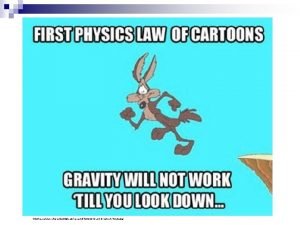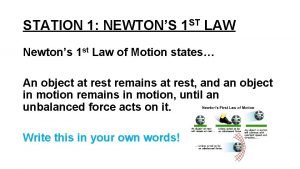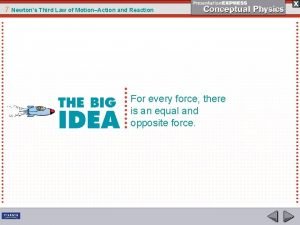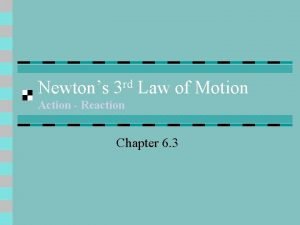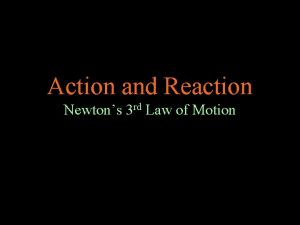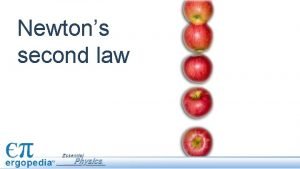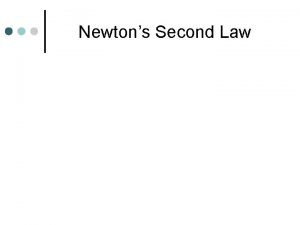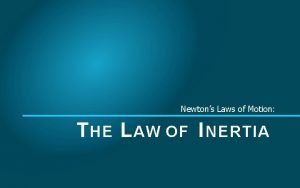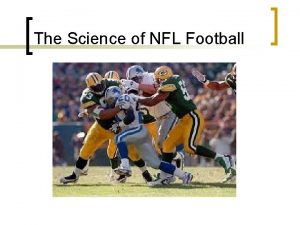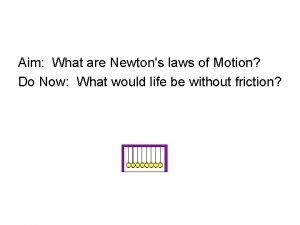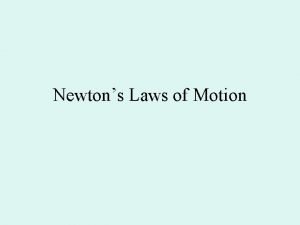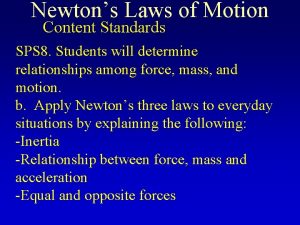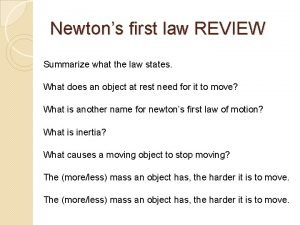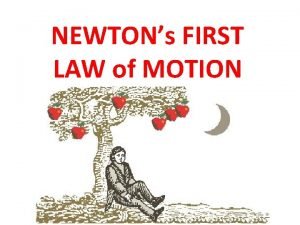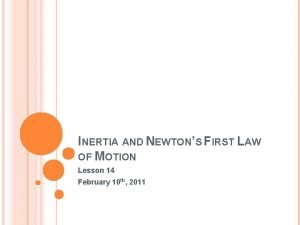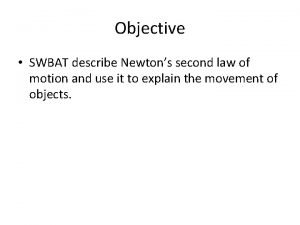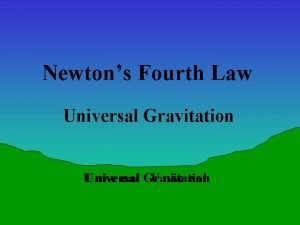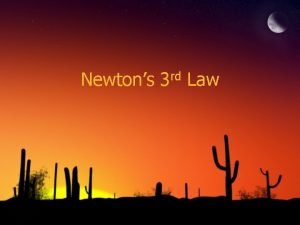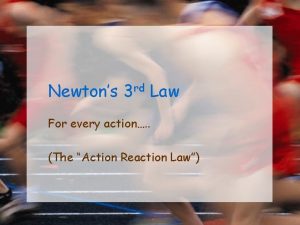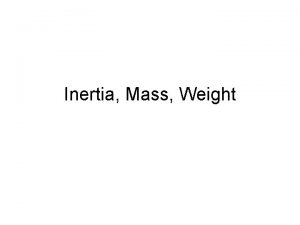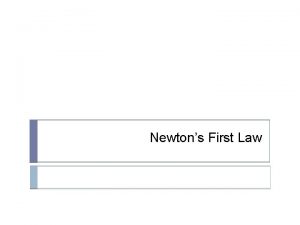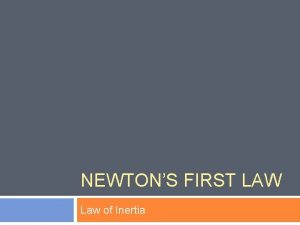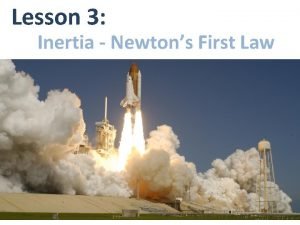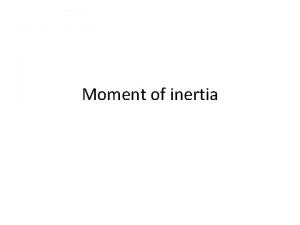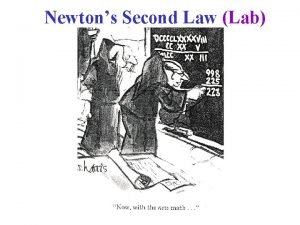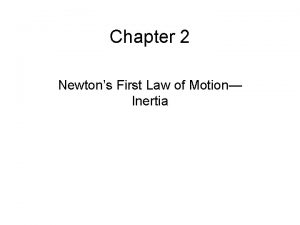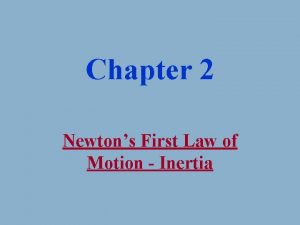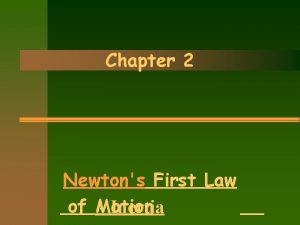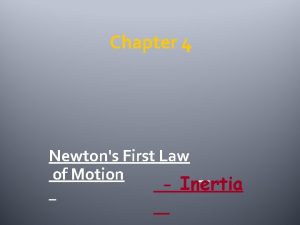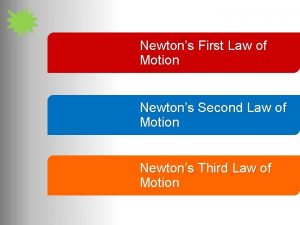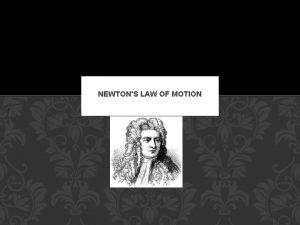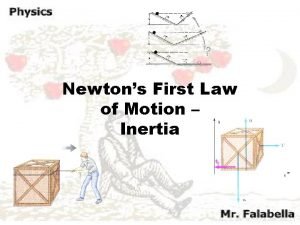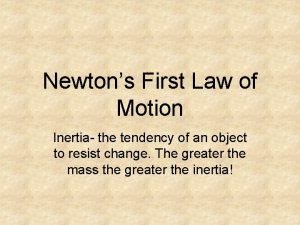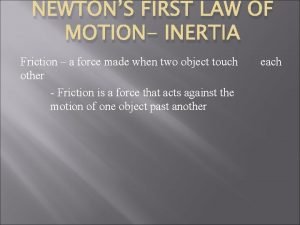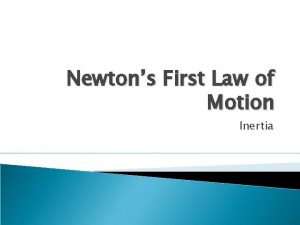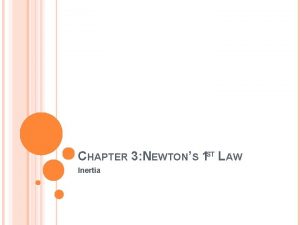NEWTONS FIRST LAW OF MOTION INERTIA Chapter 2








































- Slides: 40

NEWTON’S FIRST LAW OF MOTION - INERTIA Chapter 2

FAMOUS PHYSICISTS VIEWS ON MOTION

�The idea that a force causes motion goes back to the 4 th Century B. C. and the Ancient Greeks.

Aristotle �Motion �Divided motion into two main classes: �Natural motion �Violent motion

Natural Motion �He felt that every object in the universe had a proper place determined by its “nature” �Any object not in its proper place will strive to return to its proper place �Natural Motion on Earth was thought to be either straight up or straight down

Violent Motion �Resulted from pushing or pulling forces �Violent motion had to be imposed by something

�The normal state of objects is at rest �With the exception of celestial objects �Aristotle taught that all motions are due to a sustained push or pull. �Provided that an object is in its proper place, it will not move unless subjected to a force.

Copernicus �Polish astronomer �Believed that the sun was at the center of the universe, not the earth as previously taught. �He discovered this through observation �He published his findings on his death bed, because he feared persecution.

Geocentric Model vs. Heliocentric Model Earth at the Center Sun at the Center

Galileo �He was the first to provide conclusive proof through observation and experiment, that the sun was at the center of the universe not earth.

The Leaning Tower of Pisa �He found that objects of various weights, when released at the same time, fell together and hit the ground at the same time.

Galileo’s Inclined Planes �Aristotle thought that an object required a push or a pull to keep it moving. �Galileo felt that an object will keep moving in a straight line forever; no push, pull, or force of any kind is necessary.

Galileo’s Inclined Planes Cont. �He tested his hypothesis �He noted that balls rolling down a hill picked up speed and ball rolling up a hill lost speed. �From this he reasoned that balls rolling along a horizontal plane would neither speed up or slow down. The ball would finally come to a rest not because of its “nature” but because of friction.

Galileo’s Inclined Planes Cont. �When there was less friction, the motion of objects persisted for a longer time and the motion had a constant speed. �Galileo thought that in the absence of friction or other opposing forces, a horizontally moving object would continue moving indefinitely. �http: //www. youtube. com/watch? v=ZUg. Yc 6 Bi 46 w �http: //www. youtube. com/watch? v=yc. FPEnp 8 Gg&feature=related

Inertia �The property of things to resist changes in motion. �Galileo’s concept of inertia would show that no force is required to keep the Earth moving forward.

MECHANICAL EQUILIBRIUM

Force �Force is a push or a pull �It can be gravitational, electrical, magnetic or a muscular effort �Force of some kind is always required to change the state of motion of an object.

Net Force �Most often, there is more than one force acts on an object. �When more than a single force acts on an object, it is considered a net force �The vector sum of forces that act on an object

�You are pushing upward on the rock with as much force as the Earth’s gravity pulls down on it. �If you push harder it will move upward, if you push less it will move downward �Holding the rock at rest means that the upward and downward forces on the rock equal zero. Therefore the net force acting on the rock is zero

Tension and Weight �The stretched spring is under a “stretching force” called tension. �There are two forces acting on the bananas �Tension providing a upward force �Weight providing a downward force

Vector �A vector is an arrow that represents the magnitude and direction of a quantity.

Vector and Scalar Quantities �Vector Quantity �A quantity such as force that has both magnitude and direction is called a vector quantity. �Force is an example of a vector quantity �Scalar Quantity �A quantity that can be described by magnitude only and has no direction �Time, area, and volume are examples of scalar quantity

Mechanical Equilibrium �A state wherein no physical changes occur. �Whenever the net force on a object is zero, the object is said to be in mechanical equilibrium. �This is known as the Equilibrium Rule

The Equilibrium Rule �For any object or system of objects in equilibrium, the sum of the forces acting equals zero. �In equation form, ΣF = 0 �Σ – stands for “the sum of” �F – stands for “forces” �The rule states that the forces acting upward on the object must be balanced by other forces acting downward to make the vector sum equal zero.

Support Force �The upward force that balances the weight of an object on a surface.

Equilibrium of Moving Objects �Equilibrium is a state of no change �When an object isn’t moving it is in equilibrium �An object moving at constant speed in a straight line is also in a state of equilibrium �ΣF = 0

NEWTON’S FIRST LAW OF MOTION Inertia…

What is Inertia? �Inertia is the property of a body to resist change to its state of motion.

Newton’s First Law of Motion �Every object continues in its state of rest, or of uniform motion in a straight line, unless acted on by a nonzero net force. �Aka the Law of Inertia �Objects at rest tend to stay at rest; objects in motion tend to stay in motion.

�Things tend to keep on doing what they are already doing. �The ancients thought that continual forces were needed in order to keep an object moving, but we now know that in fact they will continue to move by themselves.

On The White Boards… �Explain what’s going to happen? What forces are acting on it? �Pulling a table cloth out under dishes… �Jamie hits a hockey puck on the ice then proceeds to hit that same hockey puck on the street…

Which will move farther? And why? �An empty can �A can filled with sand �A can filled with nails

�The amount of inertia an object has depends on its mass. �The more mass an object has, the greater its inertia and the more force it takes to change its state of motion

What is Mass? �Mass is not a volume �Volume is a measure of space �An object can have a large mass, but take up very little space �Mass is not a weight �Mass is a measure of the amount of material in an object and depends only on the number of and kind of atoms that compose it �Weight is a measure of gravitational force acting on the object �Mass is inertia…

�The amount of material in a particular stone is the same whether the stone is located on Earth, the Moon or in Space, therefore the mass of the stone is the same in all of these locations.

Mass �The quantity of matter in an object �Mass is a measure of inertia, that an object exhibits in response to any effort to start it, stop it, or otherwise change its motion

Weight �Weight is the force of gravity on an object �Weight and mass are not the same thing, they are however proportional to each other in a given place �Objects with great mass, have great weight �Objects with little mass, have little weight

Newton �A Newton is the SI Unit for Force �Symbol = N � pound force (lbf) = 0. 225 = 1 Newton � 1 kg = 10 Newton’s �If you know the weight in kg, then all you need to do is multiply by 10 in order to get the weight in Newtons.

Why does the Earth move? �Why don’t we feel the Earth moving? Everything appears still, so how can it be moving? ? ?

Objects move with the Earth �The Earth moves at a rate of 30 km/s �Everything on Earth also moves at this rate �The Law of Inertia states that objects in motion remain in motion if no unbalanced forces act on them.
 Newton's first law meme
Newton's first law meme 1st law of motion
1st law of motion Newtons 3 rd law of motion
Newtons 3 rd law of motion Newtons 3 rd law of motion
Newtons 3 rd law of motion Third
Third Newtons 3 rd law of motion
Newtons 3 rd law of motion Newtons third law of motion
Newtons third law of motion Newton's third law
Newton's third law Newtons 3 rd law of motion
Newtons 3 rd law of motion What are newton's 3 laws
What are newton's 3 laws Newtons 3 rd law of motion
Newtons 3 rd law of motion 2nd law of motion
2nd law of motion 2nd law of motion examples
2nd law of motion examples Newtons law of motion
Newtons law of motion Newton's law
Newton's law Newtons laws
Newtons laws What is motion
What is motion Newton's first law and second law and third law
Newton's first law and second law and third law Si unit of newton's first law
Si unit of newton's first law Newtons laws od motion
Newtons laws od motion What are newton's 3 laws
What are newton's 3 laws Newtons 3 laws of motion
Newtons 3 laws of motion Law of motion 3
Law of motion 3 Newtons second aw
Newtons second aw Newton's first law of motion - science of nfl football
Newton's first law of motion - science of nfl football Newton's first law of motion
Newton's first law of motion Bottle rocket designs
Bottle rocket designs Newton's first law of motion
Newton's first law of motion Newton's first law of motion
Newton's first law of motion Newton's second law in soccer
Newton's second law in soccer Find the mass of a football player who weighs 1250 n
Find the mass of a football player who weighs 1250 n Newton's law of motion
Newton's law of motion When the pellet fired into the spiral tube
When the pellet fired into the spiral tube Whatthelaw
Whatthelaw Newton's 1st law
Newton's 1st law Newton's first law of motion
Newton's first law of motion Cause of motion
Cause of motion Describe newtons second law
Describe newtons second law фанфик newton's fourth law
фанфик newton's fourth law Newton's 3 law
Newton's 3 law Newtons 3 rd law
Newtons 3 rd law
